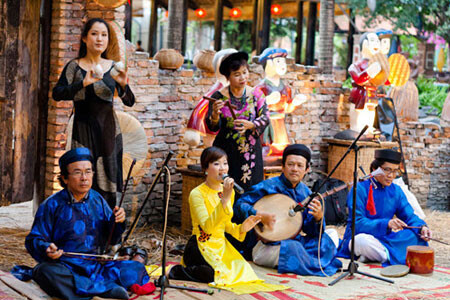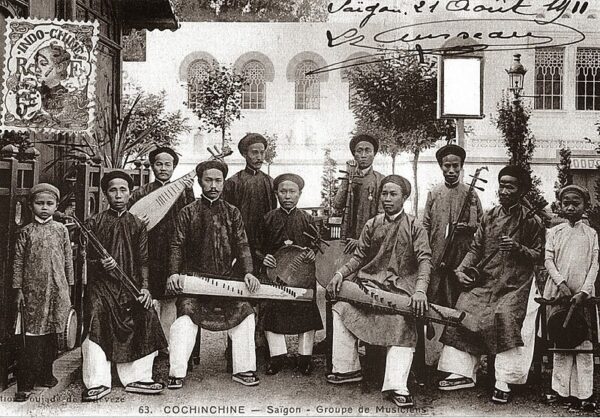ART OF DON CA TAI TU MUSIC AND SONG IN THE SOUTH OF VIET NAM
Art of Don ca tai tu music and song in the South of Viet Nam (also known as Don ca tai tu) is a specific folk art type of Viet Nam, developed in the South region in the late nineteenth century. People in Southern Viet Nam consider Don ca tai tu as an indispensible spiritual cultural activity in festivals, death anniversary rituals and celebratory social events like weddings and birthdays… The death anniversary of the ancestors held annually on the twelfth day of the eighth lunar month.
THE HISTORY OF DON CA TAI TU
According to Le Quy Don and Phan Huy Chu, even in the 17th century, the Dong Nai region and from Saigon onwards were still thousands of miles of dense forests, with many canals and waterways, and it was impossible to travel by road. Until the Nguyen Dynasty introduced the policy of land reclamation and land reclamation, many people from different classes, circumstances, and positions from the North, from the Central region, especially from Thuan – Quang moved to this fertile land. Since then, the Southern region, with its coexistence and exchange of experiences in production and labor, and the unique cultural features of many ethnic groups, who have worked hard and suffered together, has formed customs, habits, melodies of songs, rhymes, lullabies, etc., and formed Southern folk songs. Southern folk songs are an important factor in creating Southern amateur music.
In recent years, some people have claimed that the composition of Southern amateur music was created by Mr. Nguyen Quang Dai (Ba Doi), a musician of the Hue court who wandered to Can Duoc district, Long An province in the late 19th century, but there is not enough evidence to confirm this. Recently, through documents, it has been shown that the Tu Dai Oan version, one of the main versions of Oan, was composed by Mr. Nguyen Quang Quon, from Vinh Long, and the Van Thien Tuong version was composed by Professor Tran Van Khue’s grandfather… which shows that the music of Southern amateur music was created by many people, many generations, not just Mr. Nguyen Quang Dai.
In the early 20th century, the Don Ca Tai Tu movement in Bac Lieu (now Ca Mau – Bac Lieu) began to appear among the people in each group in the community. Among those groups, there was the famous Don Ca group led by Mr. Nhac Khi (now called the late founder of Nhac Khi). He not only discovered the seeds in the movement, gathered forces to train, and trained more talented people who were passionate about Don Ca. He was very dedicated to the profession and had a great desire to make the Don Ca Tai Tu movement in Bac Lieu much better than in the Western region and even better than the Don Ca Tai Tu movement in the Eastern region. Better not only in terms of the movement, but better here also means playing well, singing well, not out of rhythm, not losing the root, not hybrid, but always being creative, accepting and adding new elements so that the Don Ca Tai Tu music of the South becomes increasingly richer and the Don Ca Tai Tu music of the South has the nuances of Bac Lieu in it. With such a mind, he often said a famous sentence that is still valid in practice today: “Playing amateur music is like going to war, if you sing with the wrong lyrics, the wrong rhythm, the wrong tone, the wrong music, the wrong rhythm, it is considered not amateur music”, that is why the group of people who studied with him and worked with him mostly became talented people. Among those talented people, Bac Lieu created its own uniqueness in Southern amateur music. These are the songs Tu Buu Lien Thanh, Mau Don Thuan Hoa Bac Lieu, Lieu Giang – Ngu Quang Bac Lieu, … and hundreds of modernized songs by musician Mong Van. In particular, musician Cao Van Lau was an excellent student of Mr. Nhac Khi who composed the song Vong Co Bac Lieu – Da Co Hoai Lang, enriching the Southern amateur music, the traditional music of the Vietnamese people. The above songs have been used nationwide since then. The Southern amateur music movement in Bac Lieu – Ca Mau has grown stronger and stronger and in reality, many talented people have appeared. In addition to musicians Cao Van Lau, Mong Van, Ba Chot, there are also Miss Ba Vam Leo, Mr. Nam Nghia, Mr. Muoi Khoi, Mr. Hai Thom… these people have brought glory to the homeland during the two periods of the Southern amateur music competition in Saigon in 1935 and 1938. During the resistance war against the US to save the country, although the reformed school was popular, although the war was fierce, the Southern amateur music movement in Bac Lieu – Ca Mau, both in the temporarily occupied areas and in the liberated areas, was still active, because in the urban areas there were still poor people, many people admired it, and in the liberated areas, due to the fierce nature of the war, the groups of amateur music were very suitable. Don ca tai tu not only serves the people, but is also a means to mobilize and propagate the Party’s policies and guidelines, raise funds to support the poor, support and relieve hunger in flood-affected areas… As soon as the sound of artillery and bombs stops, the sound of Don ca tai tu in the South rises again. The sound of music and singing is always present in the life of every person, in the days of joy of victory, in the marches on the vast fields, on the rivers and canals crisscrossed between the vast forests of cajuput and mangrove.
DON CA TAI TU’S FEATURES
Don ca tai tu has been influenced by some other forms of cultural heritage from the Central and South of Viet Nam such as ceremonial music (nhac le), classical theatre and folk song (hat boi). The repertoire of Don ca tai tu is based on 20 principal songs (bai to) and 72 classical songs (bai nhac co).
Instruments for Don ca tai tu performance include the moon-shaped lute (kim), two-stringed fiddle (co), 16-string zither (tranh), pear-shaped lute (ty ba), percussion (song lang), monochord (bau) and bamboo flute (sao). The violin and guitar are adapted. Don ca tai tu is performed within hereditary musical families and by music ensembles and clubs. The audience can join practicing, making comments or creating new song texts.
Don ca tai tu practitioners include master instrumentalists (thay don), master lyricists (thay tuong), master singers (thay ca), instrumentalists (danh cam) and singers (danh ca).
DON CA TAI TU’S CLUB THROUGHT VIETNAM
The statistics implemented in 2011 showed that Don Ca Tai Tu has been practiced in more than 2,500 clubs, groups and families in 21 provinces and cities in southern region of Vietnam, including An Giang, Ba Ria – Vung Tau, Bac Lieu, Ben Tre, Binh Dương, Binh Phuoc, Binh Thuan, Ca Mau, Can Tho, Dong Nai, Dong Thap, Hau Giang, Ho Chi Minh City, Kien Giang, Long An, Ninh Thuan, Soc Trang, Tay Ninh, Tien Giang, Tra Vinh and Vinh Long.
Don Ca Tai Tu was honored to be officially acknowledged as an Intangible Cultural Heritage of Humanity at the 8th session of the Intergovernmental Committee for the Safeguarding of the Intangible Cultural Heritage held in Baku City (Azerbaijan) on 5th December 2013./.
To understand deeper about the culture in the south of VietNam: MekongDelta Region. Do not be hesitate to contact us for booking the tour or check our reviews from all my guests join with us via Tripadvisor MekongEcoTravel: https://www.tripadvisor.com/Attraction_Review-g303942-d26314076-Reviews-MekongEcoTravel-Can_Tho_Mekong_Delta.html



